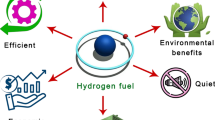Abstract
A method for enhancing the adsorption capacity of previously obtained [1] adsorbents by altering their charge composition is described. The structures and properties of the adsorbents molded with conventional wood tar and petroleum binders are compared. Scarcity of wood tar is restraining production growth and broadening of range of carbon adsorbents.
Similar content being viewed by others
REFERENCES
Yu. V. Pokonova and L. I. Zavertkina, Khim. Tekhnol. Topl. Masel, No. 1, 41-43 (2000).
Yu. V. Pokonova, Ibid., No. 3, 46-49 (2001).
Yu. V. Pokonova and V. S. Fainberg, Shale Chemistry. Science and Technology Review. Technology of Organic Matters [in Russian], Vol. 10, Izd. AN SSSR, Moscow (1985), p. 320.
Yu. V. Pokonova, High-Efficiency Carbon Adsorbents from Petroleum Residues [in Russian], TsNIITÉneftekhim, Moscow (1986), p. 59.
Yu. V. Pokonova and A. I. Grabovskii, Neftepererab. Neftekhim, No. 3, 24-26 (1987).
Yu. V. Pokonova and G. Speit, Use of Oil Residues [in Russian], Investment Company “Sintez” (Synthesis), St. Petersburg (1992), p. 291.
Author information
Authors and Affiliations
Rights and permissions
About this article
Cite this article
Pokonova, Y.V., Zavertkina, L.I. Carbon Adsorbents from Petroleum Binders. Chemistry and Technology of Fuels and Oils 37, 278–282 (2001). https://doi.org/10.1023/A:1012316123373
Issue Date:
DOI: https://doi.org/10.1023/A:1012316123373




